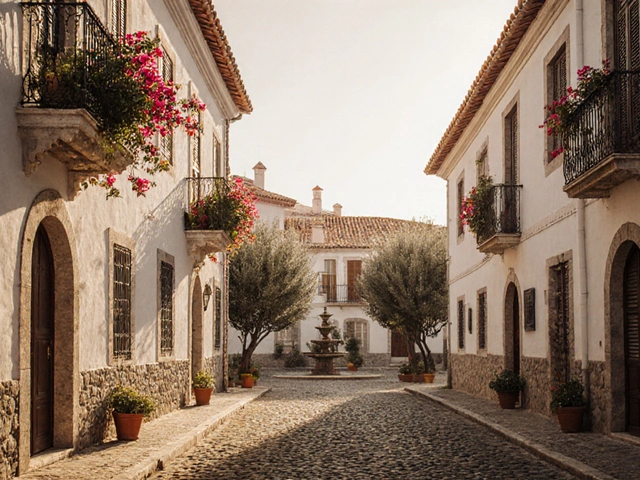Imagine walking down a street where every house looks like it was pulled straight from a sun-drenched village in Italy or Spain. Whitewashed walls, red tile roofs curling gently at the edges, ironwork balconies heavy with bougainvillea, and arched doorways that seem to invite you inside. This isn’t a vacation photo-it’s real architecture, and it’s been shaping neighborhoods across the U.S., Australia, and beyond for over a century. Welcome to Mediterranean revival architecture.
What Exactly Is Mediterranean Revival Architecture?
Mediterranean revival architecture isn’t one single style-it’s a mix. It pulls from Spanish, Italian, and North African design traditions, then blends them into something new. It started showing up in the U.S. in the late 1800s, but really took off between 1915 and 1930. That’s when wealthy Americans, tired of stiff Victorian homes, wanted something warmer, more relaxed. Architects responded by borrowing elements from coastal towns in Catalonia, Sicily, and Andalusia.
The style isn’t about copying old buildings. It’s about capturing a feeling: slow living, outdoor living, and a deep connection to the sun and sea. Even today, you’ll see it in Florida resorts, California beach houses, and here in Adelaide, where the climate mirrors the Mediterranean’s long, dry summers and mild winters.
The Signature Features You Can’t Miss
If you’ve ever seen a Mediterranean revival home, you probably noticed these five things right away:
- Stucco walls-smooth, thick plaster finishes in white, cream, or soft earth tones. They’re not just pretty; they reflect heat and keep interiors cool. In places like Arizona or South Australia, this isn’t a design choice-it’s a survival tactic.
- Terracotta roof tiles-curved, unglazed, and reddish-brown. These tiles are heavy, durable, and last 50 to 100 years. They’re not cheap, but they don’t need replacing every decade like asphalt shingles.
- Arched windows and doorways-round, horseshoe, or even slightly pointed. Arches aren’t just decorative. They distribute weight better than square frames, letting builders make wider openings without extra support.
- Ironwork balconies and railings-often hand-forged, with scroll patterns or floral motifs. These aren’t just for looks. In warmer climates, they provide shade and airflow while keeping kids and pets safe.
- Tile accents and courtyards-mosaic tiles around fountains, in entryways, or along walkways. Courtyards are central to the design. They’re private outdoor rooms, often with citrus trees, fountains, or stone benches. No TV here-just the sound of water and birds.
Some homes even have bell towers or minaret-style chimneys. These aren’t religious symbols-they’re nods to Moorish and Spanish heritage. The goal? To make the house feel like it’s been there for generations, not built last year.
Where Did This Style Come From?
The roots go deep. Spanish colonists brought their building traditions to Florida and California in the 1500s. Those early adobe homes had thick walls, flat roofs, and small windows-perfect for desert heat. But Mediterranean revival didn’t start until the 1880s, when Americans began traveling to Europe and fell in love with the look of coastal villages.
The 1915 Panama-California Exposition in San Diego was a turning point. Architects recreated Spanish Colonial buildings from the 1700s, and the public went wild. Suddenly, everyone wanted a home that looked like it belonged in Seville or Portofino. By the 1920s, builders in Florida were cranking out Mediterranean-style resorts for winter visitors. The Breakers in Palm Beach? That’s one of the earliest and grandest examples.
In Australia, the style took off after World War II. Returning soldiers and immigrants from Italy and Greece brought their love of outdoor living. Builders adapted the look to local conditions-using local limestone instead of imported stone, and adding verandas to handle Australia’s harsh sun. Today, you’ll find Mediterranean revival homes in suburbs like Brighton and Glenelg, often with added pergolas and olive trees.

Why It Still Works Today
Some people think Mediterranean revival is just a nostalgic trend. But it’s still popular for real reasons.
First, it’s built for comfort. Thick stucco walls, high ceilings, and shaded courtyards naturally regulate temperature. You don’t need air conditioning as much. In a world where energy efficiency matters, that’s a huge plus.
Second, it’s adaptable. You can build a small Mediterranean cottage or a sprawling estate. The style works on urban lots and rural properties alike. Many modern builders combine it with passive solar design-large south-facing windows in winter, deep overhangs in summer.
Third, it feels timeless. Unlike trendy minimalist homes that look dated in 10 years, Mediterranean revival has depth. The materials age well. Stucco gets a patina. Ironwork develops a rustic rust. Tile floors wear in, not out. It’s architecture that tells a story.
Common Mistakes When Building or Renovating
Not every home with a red roof and stucco walls is true Mediterranean revival. Here are the biggest errors people make:
- Using synthetic stucco-EIFS (Exterior Insulation and Finish Systems) looks like stucco but traps moisture. In humid climates, that leads to mold and rot. Real stucco is a mix of sand, lime, and cement-applied in three coats. It breathes.
- Choosing the wrong roof tiles-some builders use lightweight concrete tiles that look like terracotta but crack in freeze-thaw cycles. True terracotta is fired clay. It’s heavier, pricier, but lasts longer.
- Overdoing the ornamentation-too many arches, too much ironwork, and it looks like a theme park. Mediterranean revival is about balance. One elegant archway is more powerful than five awkward ones.
- Ignoring the landscape-this style doesn’t work with manicured lawns. Think drought-tolerant plants: lavender, rosemary, agave, and citrus trees. Gravel paths and stone walls tie it all together.
And don’t forget the color palette. Bright white is classic, but avoid pastels like baby blue or mint green. True Mediterranean homes use warm neutrals: ochre, sienna, cream, and soft gray. These colors blend with the earth, not fight against it.
Modern Takes on a Classic Style
Today’s architects aren’t just copying old blueprints. They’re reimagining Mediterranean revival for today’s needs.
Some use solar panels disguised as roof tiles. Others install hidden rainwater tanks under courtyards. Open-plan interiors are now common-big living areas flowing into outdoor dining spaces. Glass doors replace heavy wooden ones to let in more light.
In Australia, builders are using recycled brick and locally sourced stone to cut carbon footprints. Some homes even have green roofs on lower levels, blending into the hillside. It’s not just about looks anymore-it’s about sustainability with soul.
One standout example is the 2023 renovation of a 1930s home in Glenelg. The owners kept the original stucco, tile roof, and arched entry-but added triple-glazed windows, geothermal heating, and a rooftop solar array. The result? A home that looks like it’s been there since the 1920s, but uses 70% less energy.

How to Spot a True Mediterranean Revival Home
If you’re looking to buy or just curious, here’s how to tell real from fake:
- Check the roof-true terracotta tiles are uneven, hand-made, and slightly curved. Machine-made tiles are perfectly uniform.
- Look at the walls-real stucco has a slightly rough texture. Painted drywall or synthetic finishes look too smooth.
- Examine the ironwork-hand-forged iron has small imperfections, slight bends, and unique patterns. Mass-produced iron is too perfect.
- Walk around the back-true Mediterranean homes often have service courtyards, storage sheds, or wine cellars built into the side or rear.
- Check the date-most authentic homes were built between 1915 and 1940. Anything built after 1980 is likely a revival, not original.
And here’s a pro tip: walk through the house at noon. If the interior stays cool without AC, you’re likely in a real one. The walls are thick enough to store cool air from the morning and release it slowly through the day.
Where to See the Best Examples
If you want to see Mediterranean revival in person, here are a few standout places:
- Florida-Palm Beach, Coral Gables, and St. Augustine are packed with grand examples. The Biltmore Hotel in Coral Gables is a masterpiece.
- California-Santa Barbara is known as the “American Riviera.” Nearly every public building and many homes here follow the style.
- Australia-Look in Adelaide’s beachside suburbs like Glenelg, Brighton, and Seacliff. Many homes from the 1920s-1950s still stand, often beautifully restored.
- Italy and Spain-Visit towns like Portofino, Ravello, or Cádiz. These are the originals. Seeing them helps you understand why the revival style works so well.
You don’t need to travel far. Even in your own neighborhood, take a drive on a quiet street with mature trees. You might be surprised how many hidden gems are tucked behind hedges and gates.
Is Mediterranean revival architecture expensive to maintain?
It depends. Terracotta roofs and hand-made stucco cost more upfront, but they last decades with minimal upkeep. Unlike vinyl siding or asphalt shingles, they don’t need replacing every 15-20 years. The real cost comes from repairs-finding skilled artisans who know how to match old materials isn’t easy. But if you treat it right, a Mediterranean home can outlive most modern builds.
Can you add Mediterranean features to a modern home?
Absolutely. You don’t need to rebuild. Swap out a plain front door for an arched one with iron hinges. Add a small courtyard with tile flooring and a fountain. Replace your roof with terracotta tiles if your structure can handle the weight. Even painting your walls in a warm cream or ochre tone can shift the whole feel. Start small-details matter more than scale.
Does this style work in cold climates?
It can, but it needs adjustments. Thick stucco walls help insulate, but you’ll need better windows and insulation in the roof. Avoid open courtyards in snowy areas-ice buildup can damage tiles and stonework. Many homes in colder regions use enclosed patios with glass roofs instead. The key is adapting the spirit, not copying every detail.
Why do so many Mediterranean homes have fountains?
It’s not just decoration. In hot, dry climates, water cools the air. A fountain creates a microclimate-lowering the temperature around it by up to 5°C. It also masks street noise and adds a sense of calm. In traditional designs, water was sacred. Today, it’s about comfort and ambiance. You don’t need a grand fountain-a simple wall-mounted recirculating unit works just as well.
Are Mediterranean revival homes energy efficient?
Yes, if built right. Thick walls store cool air overnight and release it slowly during the day. Small windows reduce heat gain in summer. Covered verandas and courtyards provide shade without blocking breezes. Modern upgrades like solar panels, double-glazed windows, and geothermal heating make them even better. In fact, many of today’s net-zero homes borrow heavily from Mediterranean principles.
Final Thoughts: More Than Just a Style
Mediterranean revival architecture isn’t about pretending you live in Tuscany. It’s about creating spaces that feel alive-where light moves through rooms, where air flows freely, where the outside isn’t something you look at through glass, but something you step into.
It’s architecture that remembers how people used to live: slowly, deliberately, connected to the land and the seasons. In a world rushing toward glass towers and minimalist boxes, this style offers something rare-a sense of place, of history, of warmth that doesn’t come from a thermostat.
Whether you’re living in one, restoring one, or just dreaming about it, Mediterranean revival isn’t a trend. It’s a quiet rebellion against the impersonal. And it’s here to stay.



